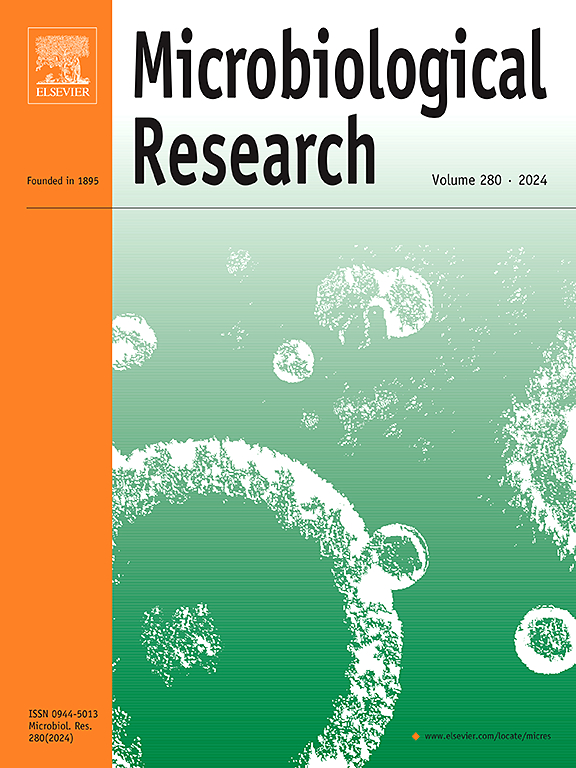铜基和生物替代处理下柑橘果实微生物组的变化及其生物防治潜力
IF 6.9
1区 生物学
Q1 MICROBIOLOGY
引用次数: 0
摘要
柑橘是一种全球重要的水果作物,拥有独特的微生物群落,对维持柑橘健康和增强抗病性至关重要。虽然柑橘根和叶微生物组的结构和形成因素,包括植物检疫处理,已经有了很好的记录,但碳圈(果实表面)微生物组及其对植物检疫输入的响应仍然知之甚少。在本研究中,我们结合了培养独立(扩增子测序)和培养依赖技术,分析了三种柑橘宿主的柑橘圈微生物组及其对田间应用植物检疫处理(生物制剂和铜抗菌剂)的响应。尽管在变形菌门、厚壁菌门和担子菌门等优势类群的相对丰度上存在宿主特异性差异,但所有三种柑橘宿主都有一个核心微生物组,在水果样品中一致存在。铜处理对细菌多样性和组成有负面影响,而生物制品(壳聚糖、甜橙精油及其混合物)的负面影响很小或没有。真菌群落,包括潜在的病原体,似乎对治疗不太敏感。网络分析证实,与未处理或生物处理的样品相比,铜改变了微生物的相互作用,增加了细菌类群之间的互斥关系,而未处理或生物处理的样品以正相互作用为主。对同一样品的可培养菌群进行平行调查,确定了潜在的生物防治剂(bca)对炭疽菌(Colletotrichum gloeosporioides)和交替菌(Alternaria alternata)的作用。值得注意的是,与核心扩增子序列变异(asv)交叉比对的可培养bca显示,81.7 %的细菌核心成员代表潜在的生物防治剂。这项研究强调了管理实践对维持有益微生物群的重要性。此外,它建立了一个有价值的核心相关bca资源,为真菌病原体的生物防治提供了有希望的途径。本文章由计算机程序翻译,如有差异,请以英文原文为准。
Citrus fruit microbiome changes under copper-based and biological alternative treatments and its biocontrol potential
Citrus, a globally significant fruit crop, harbours a distinctive microbial community crucial for maintaining citrus health and enhancing disease resistance. While the structure and shaping factors, including phytosanitary treatments, of citrus root and leaf microbiomes are well documented, the carposphere (fruit surface) microbiome and its response to phytosanitary inputs remain poorly understood. In the present study, we combined culture independent (amplicon sequencing) and culture dependent techniques to analyse the citrus carposphere microbiome across three citrus hosts and its response to field-applied phytosanitary treatments (biologicals and copper-antimicrobials). Despite host-specific variation in the relative abundance of dominant taxa such as Proteobacteria, Firmicutes, and Basidiomycota, all three citrus hosts shared a core microbiome, consistently present across fruit samples. Bacterial diversity and composition were negatively influenced by copper treatments, whereas biological products (chitosan, sweet orange essential oils and their mixtures) had minimal or no negative impacts. Fungal communities, including potential pathogens, appeared less sensitive to treatments. Network analysis confirmed that copper altered microbial interactions, increasing mutual exclusion relationships between bacterial taxa compared to untreated or biologically treated samples, which were dominated by positive interactions. A parallel survey of cultivable microbiota from the same samples identified potential biocontrol agents (BCAs) against Colletotrichum gloeosporioides and Alternaria alternata. Notably, cross-referencing cultivable BCAs with core Amplicon Sequence Variants (ASVs) showed that 81.7 % of bacterial core members represent potential biocontrol agents. This study highlights the importance of management practices for sustaining beneficial microbiomes. Furthermore, it establishes a valuable resource of core-associated BCAs, offering promising avenues for the biological control of fungal pathogens.
求助全文
通过发布文献求助,成功后即可免费获取论文全文。
去求助
来源期刊

Microbiological research
生物-微生物学
CiteScore
10.90
自引率
6.00%
发文量
249
审稿时长
29 days
期刊介绍:
Microbiological Research is devoted to publishing reports on prokaryotic and eukaryotic microorganisms such as yeasts, fungi, bacteria, archaea, and protozoa. Research on interactions between pathogenic microorganisms and their environment or hosts are also covered.
 求助内容:
求助内容: 应助结果提醒方式:
应助结果提醒方式:


